Mustang Trek Packages by A1 Excursion Adventure
Each trek and tour provides breathtaking views of the Himalayas, rich cultural experiences, and unforgettable memories here in the Mustang region of Nepal.
MAJOR ATTRACTIONS OF MUSTANG REGION
The Mustang Region gives you a very special experience. It has amazing views of big mountains and a culture that feels like Tibet. You can see Rocky Mountains, old caves, and very old monasteries that have been there for hundreds of years. This far-away part of Nepal is full of both natural beauty and interesting history.
Here are some of the best things you can see and do that make Upper Mustang one of the most exciting places to go trekking in the Himalayas:
Tiji Festival: Exploring the Spiritual Soul of Mustang
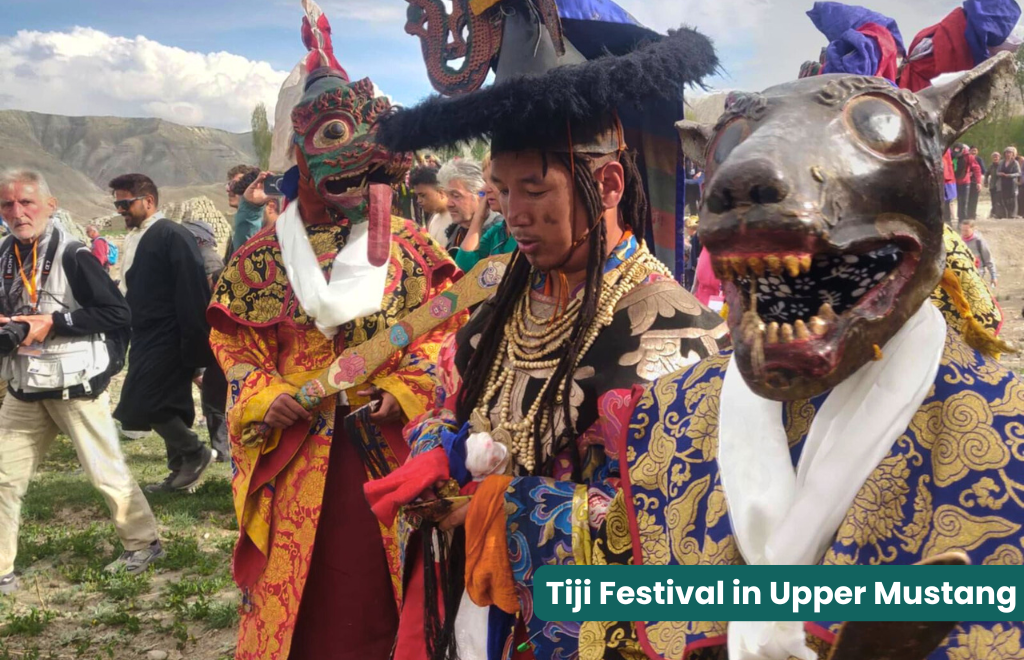
The Tiji Festival is one of the biggest and most special events in the Mustang region. It is full of bright colors and has a deep spiritual meaning. The festival lasts for three days and comes from Tibetan Buddhist traditions. The word “Tiji” comes from Tempa Chhirim, which means “Prayer for World Peace” in the local language.
Every year, the festival takes place in Lo Manthang, the old walled city of Upper Mustang. During the festival, monks from Choede Monastery wear special masks and perform traditional dances. These dances tell the story of good winning over evil. Along with the dances, people also sing, pray, and join together to celebrate with a strong feeling of peace and unity.
Tiji Festival 2026 Dates: May 14 to May 16
We also offer an exclusive guided tour package tailored to this extraordinary event. The package combines the festival's spiritual vibrance with the raw beauty of the Mustang landscape.
👉 Check out our Tiji Festival Package
Lo Manthmaang – The Ancient Walled Kingdom of Mustang
Lo Manthang is the capital of the Mustang region. It is also called the ancient Kingdom of Lo or the "Walled City" because a big wall surrounds it to keep the town safe. Walking into Lo Manthang feels like stepping into a living museum. You can see white houses made of mud bricks, small narrow streets, and a beautiful five-story royal palace that shows the old way people used to live.
This city was built in the 15th century and is still an important place for Tibetan Buddhism in Nepal. Inside the walls, you can visit Thugchen Gompa, one of the most important monasteries in the area, along with other very old temples where people still pray and follow their traditions.
Visiting Lo Manthang is not just about trekking through the big mountains. It’s also a chance to see and feel a very old Tibetan way of life that is hard to find anywhere else in the world today.
Exploring the Mysterious Sky Caves of Mustang: Jhong cave, Chungsi cave, and many more...
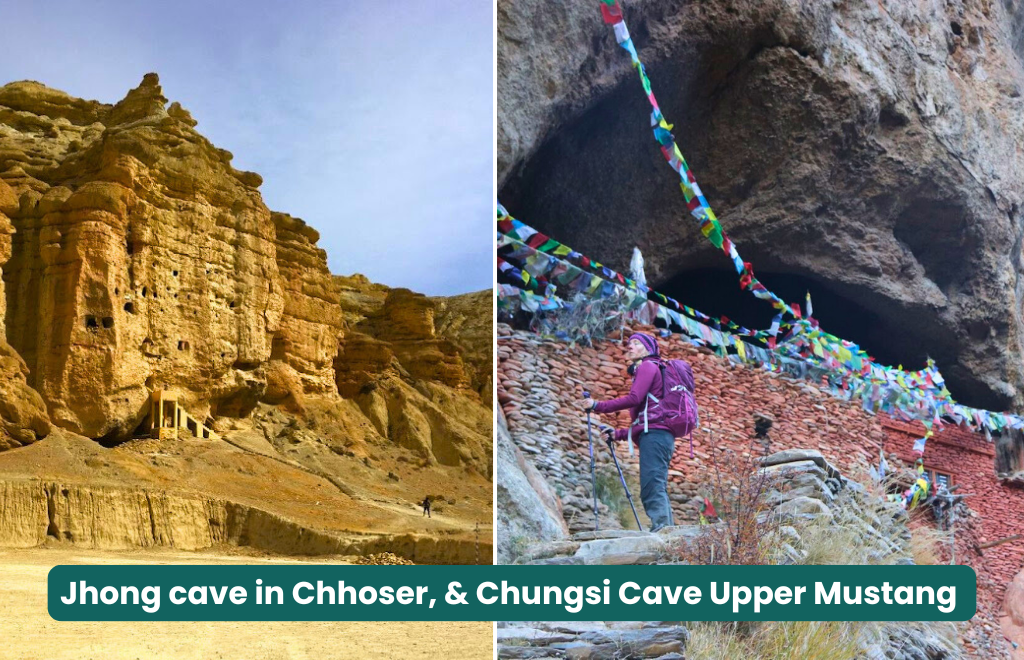
One of the most amazing things to see in Mustang is its old man-made caves. These caves are very special because they have a lot of history, spiritual meaning, and are important for scientists too. Near the village of Chhoser, you can find the famous Sky Caves, also called the “Pyramids of the Himalayas.” There are about 10,000 caves carved into the cliffs that are around 2,000 to 3,000 years old. Long ago, people used these caves for meditation, burials, and even as homes.
One of the most special caves is the Chhoser Cave, also known as Shija Jhong Cave. It looks like a five-story building built into the cliff, with over 40 rooms connected by ladders and small tunnels. In the past, people hid here to stay safe during wars.
Not far from here is the holy Chungsi Cave, also called Rangchung Cave. It is believed that great teachers like Guru Padmasambhava and even Lord Shiva meditated here. Because of this, both Buddhists and Hindus visit this cave as a holy place.
These ancient caves give visitors a rare chance to explore the deep spiritual and cultural history of the Himalayas.
Upper Mustang Trekking Adventure: A Journey Through Time and Culture
Upper Mustang sits between the faraway Dolpo region and the Manang district. People often call it Nepal’s “Last Forbidden Kingdom.” This special place was closed to outsiders until 1992. Because of this, it has kept its old Tibetan-Buddhist culture with ancient cities, old monasteries, and a way of life that has not changed much even today.
The land here looks like a desert, with wind-shaped cliffs and orange-brown valleys that seem almost like another planet. But what makes Upper Mustang truly special is its strong spiritual feeling and rich culture, which grew over many years of Himalayan trade, especially when people traded salt between Tibet and Nepal.
Coming to Upper Mustang is not just a trek. It feels like traveling back in time, into a world full of history, deep beliefs, and stunning natural beauty, all living together in perfect harmony.
Monasteries of the Mustang Region and Tibetan Buddhist Influence
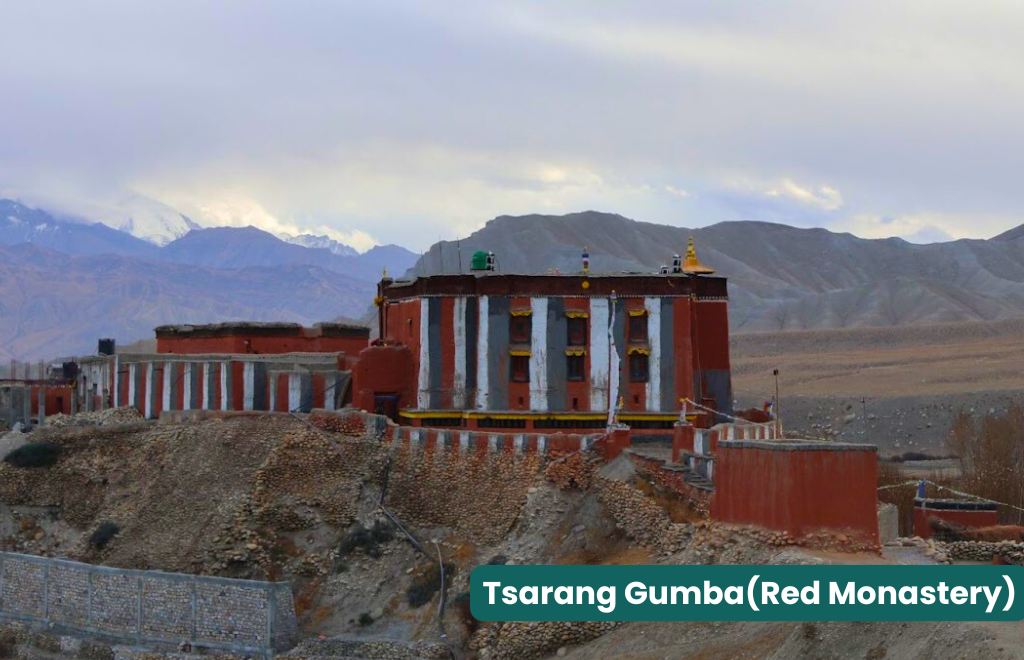
The Mustang region, located near the Tibetan Plateau, is a very special place for Tibetan Buddhism. It is filled with ancient monasteries that show the deep spiritual roots of the area.
In Lo Manthang, two important monasteries are Choede Monastery and Thugchen Gompa. They are at the heart of the region’s religious life. Another important site is Tsarang Gumba, also called the Red Monastery. It is located in the village of Tsarang and is known for its beautiful design and great spiritual value.
Lo Gekar, also known as Ghar Gumba, is believed to be one of the oldest Tibetan Buddhist monasteries in Nepal. It was built in the 8th century and is linked to Guru Rinpoche, a famous figure in Tibetan Buddhism.
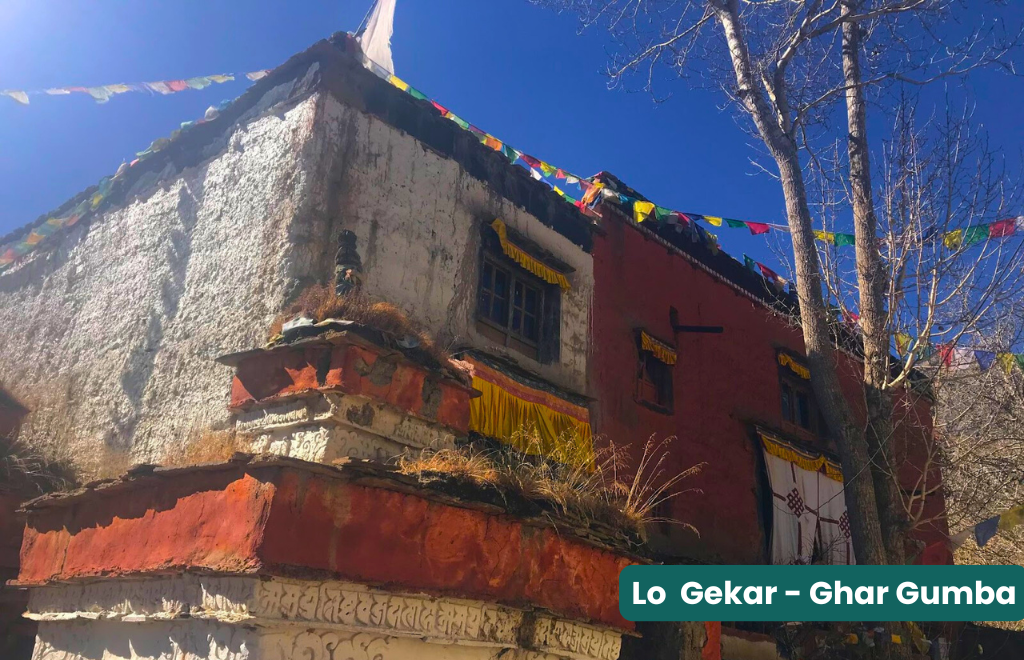
Other special places include Luri Monastery, which has ancient cave paintings, and Jomsom and Samhling Monasteries. Each of these sites shares a different part of Mustang’s rich spiritual history.
As you walk through Mustang, you will see prayer flags moving in the wind, long stone walls with carved prayers called mani walls, small white stupas, and prayer wheels. These symbols all add to the peaceful and sacred feeling of the region.
Kagbeni Village – Gateway to the Upper Mustang Region
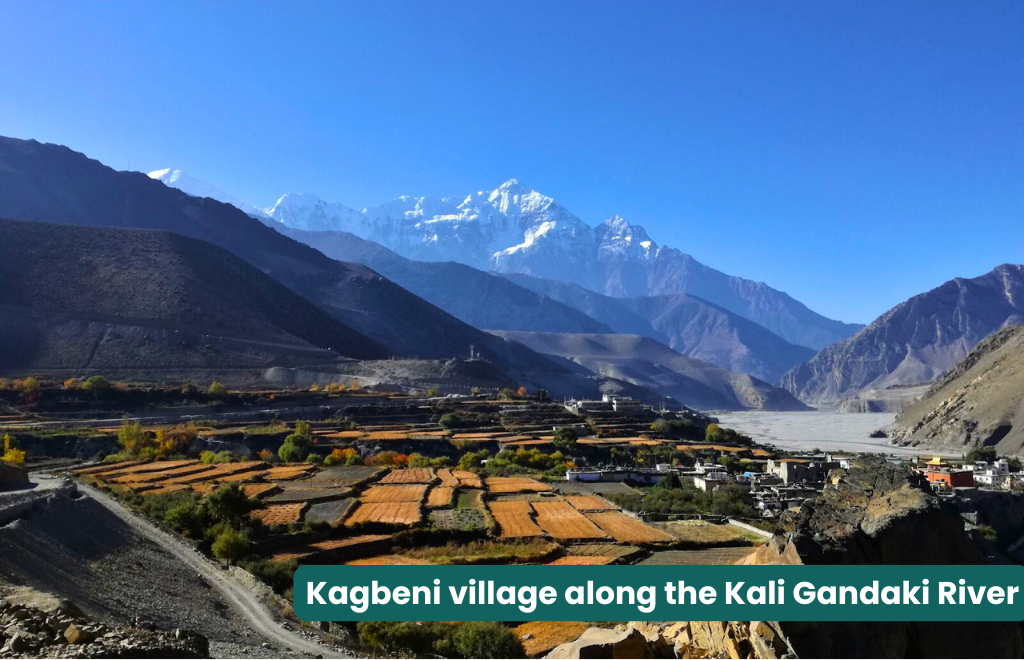
Kagbeni is a beautiful village situated by the Kali Gandaki River. It is known for its red-walled monastery and its old, charming look. Kagbeni is the official entry point to Upper Mustang.
This village is also very special for many Hindu pilgrims who stop here on their way to Muktinath, a holy place that is important for both Hindus and Buddhists.
For people starting their Upper Mustang trek, Kagbeni is the perfect place to begin. It offers a mix of natural beauty and spiritual meaning, giving trekkers their first look into the ancient culture and stunning landscapes of the region.
Dhakmar and Its Iconic Red Cliffs – Nature’s Artwork in Mustang
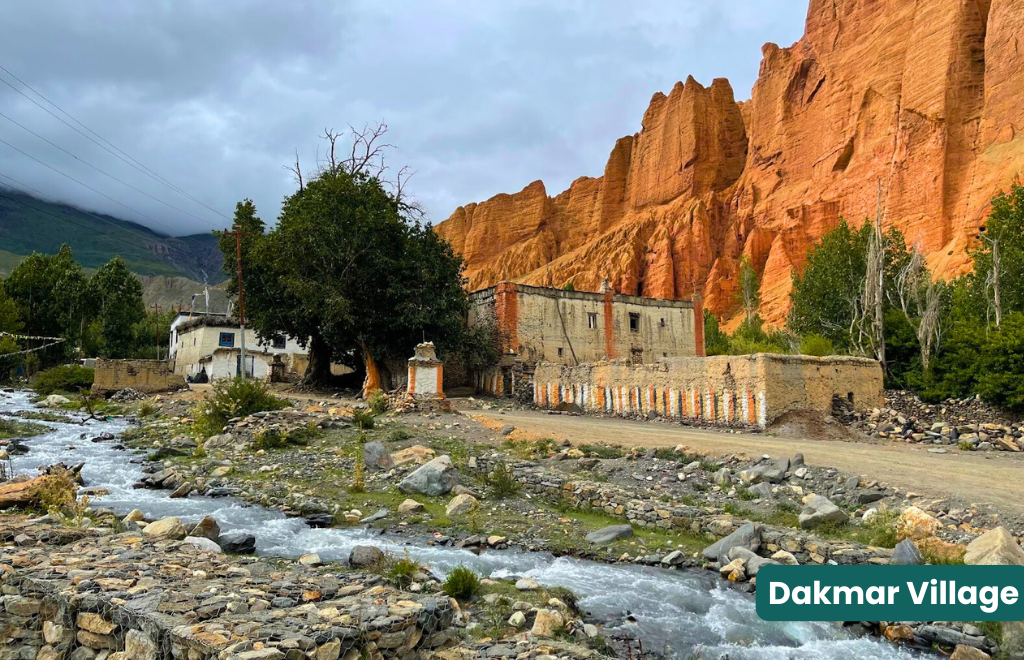
Dhakmar, in the Mustang region, is known for its bright red cliffs, which the wind has shaped for hundreds of years. According to local stories, the red color comes from the blood of demons defeated by Guru Rinpoche, a great Buddhist teacher.
The village is very peaceful, with amazing views of the red cliffs and the surrounding mountains. It’s a perfect place for quiet thinking and spiritual rest. Dhakmar’s special beauty and its deep spiritual meaning make it one of the must-visit places on the Mustang trek.
Muktinath Temple – A Sacred Pilgrimage Site in Mustang
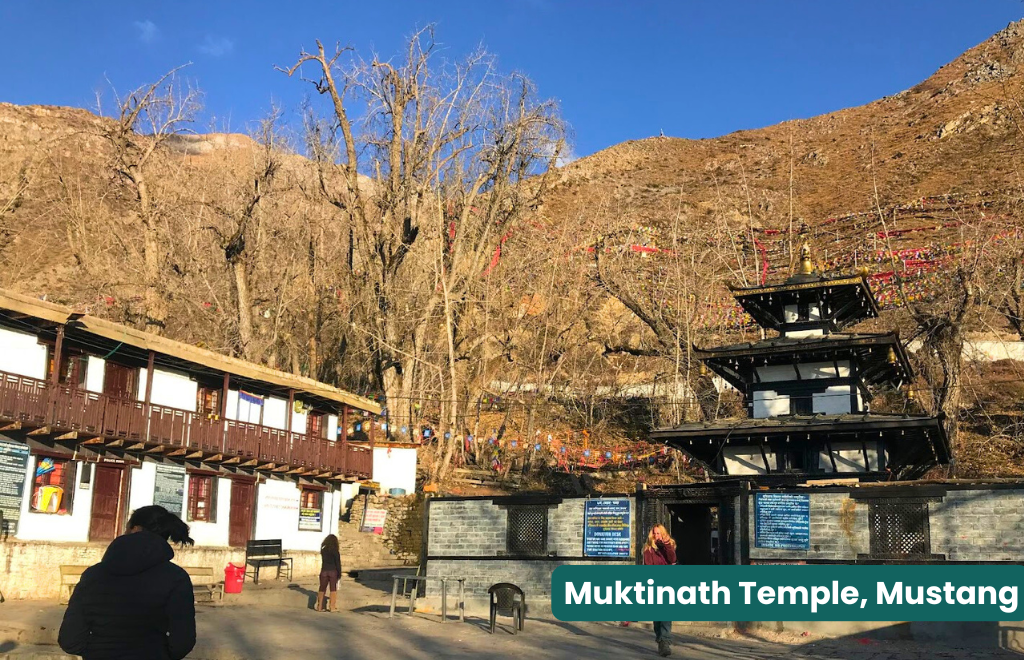
Muktinath Temple is one of the most significant spiritual destinations for both Hindus and Buddhists. Revered as a place of salvation, the temple attracts pilgrims from Nepal, India, and Tibet who come to cleanse their sins. The temple’s 108 sacred water spouts offer devotees a chance to bathe and purify themselves, fulfilling an essential ritual of the pilgrimage.
The temple also features a unique and eternal flame that burns continuously, fed by natural gas seeping from the earth. This flame is believed to be a divine manifestation, adding to the site's mystical allure.
Although Muktinath Temple lies just outside the official boundaries of Upper Mustang, it is often included in trek itineraries due to its immense religious and cultural importance.
Marpha Village – Mustang’s Apple Capital and Cultural Gem
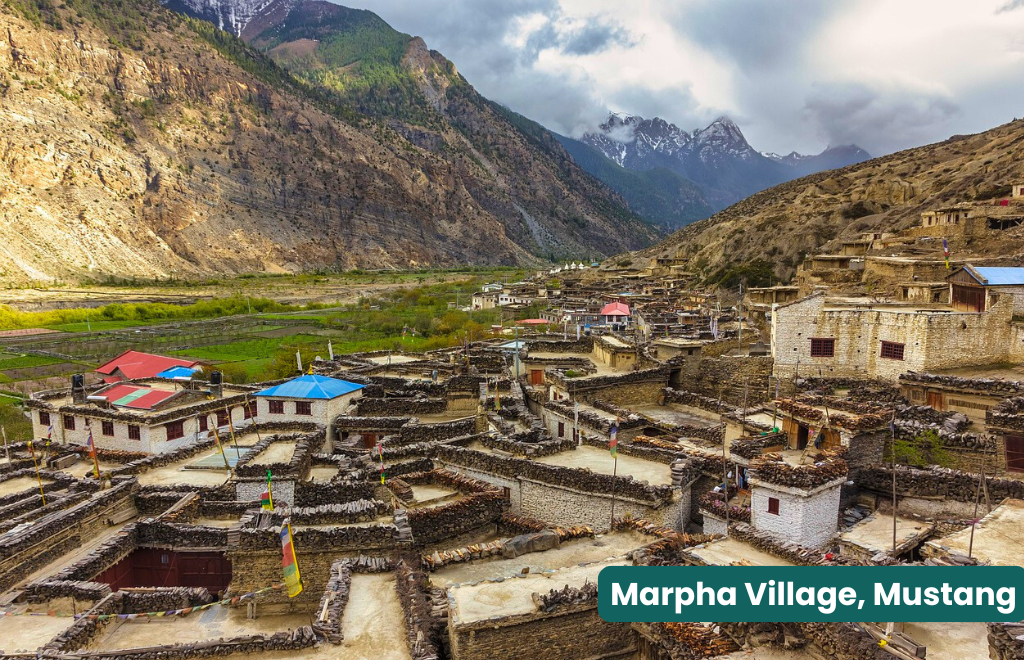
Marpha Village, located in the Lower Mustang Region, is known as the Apple Capital. Sitting at 2,700 meters, its rich soil helps grow tasty apples, which are famous for their sweet and crisp flavor. People also make apple brandy and dried apple snacks here.
The village is full of natural beauty and rich culture. You’ll see traditional white stone houses and Tibetan Buddhist monasteries. Marpha offers beautiful mountain views, a calm and peaceful feeling, and a chance to see the real daily life of Upper Mustang. It’s a perfect place to visit during your trek.
In Conclusion, Why the Mustang Region Deserves a Spot on Your Bucket List
The Mustang region is more than just a place to visit – it feels like stepping into a world where time has stood still. With its tall red cliffs, ancient monasteries, and strong Tibetan Buddhist traditions, this hidden part of Nepal offers a truly special adventure. Whether you're walking through colorful mountain paths, watching the lively Tiji Festival, or exploring old caves, every moment in Mustang is full of beauty, peace, and wonder.
If you’re looking for a once-in-a-lifetime journey in the Himalayas, Mustang is a place you won’t want to miss. Join A1 Excursion Adventure and experience the magic of Nepal's Mustang region like never before.
Contact Us Today to Book Your Mustang Region Trek!
FAQs
1. What is the Mustang region in Nepal?
The Mustang region is a remote area in northern Nepal known for its breathtaking Himalayan landscapes, ancient Tibetan Buddhist culture, and well-preserved historical sites. It is divided into Upper Mustang and Lower Mustang.
2. Why is the Mustang region called the Forbidden Kingdom?
The Mustang region was closed to foreigners until 1992, earning it the name "Forbidden Kingdom." Its isolation helped preserve its ancient culture, monasteries, and unique way of life.
3. When is the best time to visit the Mustang region?
The best time to visit the Mustang region is from March to November. Since it lies in a rain shadow area, even the monsoon months (June-August) are suitable for trekking.
4 How difficult is trekking in the Mustang region?
Trekking in the Mustang region is considered moderate. While you don’t need technical climbing skills, trekkers should be prepared for long walking days and high altitudes, especially in Upper Mustang.
5 Do I need a special permit to visit the Mustang region?
Yes. To trek in Upper Mustang, you need a special Restricted Area Permit along with an Annapurna Conservation Area Permit (ACAP). Lower Mustang requires only the ACAP.
6. What is the Tiji Festival in the Mustang region?
The Tiji Festival is a 3-day Buddhist celebration held in Lo Manthang, the ancient capital of the Mustang region. Monks perform masked dances symbolizing the victory of good over evil, attracting both locals and tourists.
7 What are the main attractions in the Mustang region?
Key attractions in the Mustang region include Lo Manthang, the Tiji Festival, the Sky Caves of Chhoser, Kagbeni, Dhakmar’s red cliffs, Marpha village, ancient monasteries, and the beautiful Himalayan scenery.
8 How high is the Mustang region?
The Mustang region sits at elevations ranging from 2,800 meters (Lower Mustang) to over 4,000 meters (Upper Mustang). Lo Manthang, the main city of Upper Mustang, is at 3,840 meters.
9 Is the Mustang region suitable for beginners?
The Mustang region is beginner-friendly if you are physically fit and prepared for the altitude. Hiring a local guide is highly recommended for safety and cultural insights.
10 Why should I visit the Mustang region?
The Mustang region offers a unique blend of ancient culture, unspoiled landscapes, spiritual experiences, and Himalayan trekking that few other destinations can rival. It’s perfect for travelers looking for something truly unique in Nepal.











-1.webp)
-1.webp)
.webp)